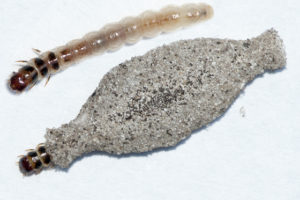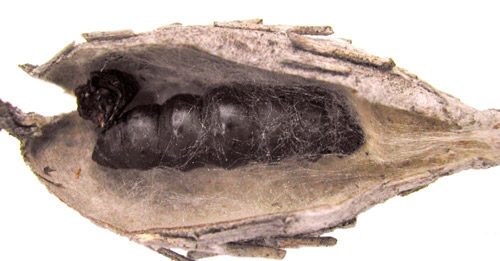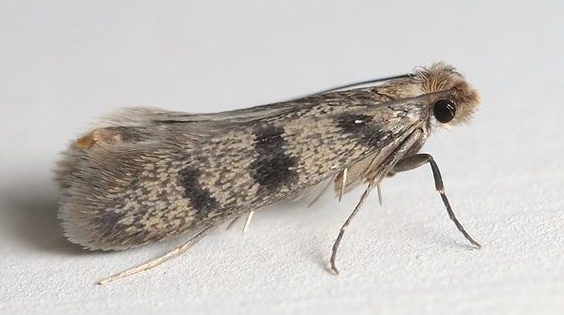Do you keep seeing moth flying around your home or small cocoons hanging from your ceiling?
Plaster bagworms are annoying and hard to get rid of.
Don’t worry, I’ve got you covered.
In this post, I will help you identify if you have plaster bagworms and give you different ways you can use to get rid of them.
Let’s dive in.
What do Plaster Bagworms look like?
The first step to getting rid of the plaster bagworm in your home is identifying it correctly.
Here are some key features you should look for.
Eggs
The eggs of the plaster bagworm as very small. They measure around 0.4mm.
Females can lay hundreds of eggs at a time.
She will place these along wall or floor junctions and use debris to hide them and keep them in place.
Larva
The larva is unique because most people don’t see it.
The larva constructs a silken case that it hides inside.
The larva will take this everywhere until it is ready to leave.
The silken case typically takes the shape of a pumpkin seed.
It’s often slender, flat, and composed of different materials such as debris and silk fibers.
The larva itself is all white with a blackhead. They reach around 7mm.

Pupa
The pupa stage takes place inside the silken case.
The lava will attach the silken case to a wall and make a slit.
Once it goes through the eclosion, the larva will come halfway outside of the case.

Adult
After going through the eclosion period, the pupa emerges as a moth.
The females are around 10 – 13mm long. Males are typically smaller, only measuring around 7 to 9mm.
Both moths have dense hairs on their heads. They are typically grey to light brown with a few patches on their wings.

How To Get Rid Of Plaster Bagworms?
Unlike other pests that enter your house, its not always easy as spraying chemicals. But there are several much easier methods you can use to get rid of plaster bagworms.
Let’s get started.
1. Deep Clean
One of the easiest ways to get rid of the plaster bagworms is to do a deep cleaning.
Plaster bagworms survive off organic materials such as cobwebs, silk fibers, hair, and other organic debris found around your home.
You’ll commonly find them inside plaster walls, on walls, or hanging from ceilings.
To keep these pests out of your home, make sure you vacuum regularly and thoroughly.
You want to make sure you get any fibers or organic materials that may be on your walls or floors.
You’ll also want to get rid of any old spider webs around your house.
Plaster bagworms are small. So, even a small line of a spider web can feed them for quite a long time.
It’s important that you look for spider webs on your walls, any cracks, foundation, behind appliances, and corners.
Eliminating food sources for the plaster bagworm will make your home less appealing.
Maintaining the cleanliness of your home is crucial to controlling these pests inside your home.
2. Control Humidity
Plaster bagworms thrive in humidity and moisture.
This is one of the reasons Florida and other coastal states experience most of the infestations.
Eliminating moisture and humidity will make it harder for them to survive.
To minimize humidity,
use a dehumidifier and keeping your air conditioner on.
Place your dehumidifiers in areas where plaster bagworms are common.
This is typically in dark and undisturbed locations such as closets or unused rooms. Often, closets and smaller rooms will not have an air conditioner. This is why it’s essential to make sure you use a humidifier in these rooms.
If you don’t have an air conditioner or humidifier, you can keep air circulating in your home by leaving your windows open, keeping box fans in your home.
This will help reduce humidity in your home.
It is important that if you do leave your windows open that you have window screens on.
Without window screens, there is the possibility that more bagworms enter your home.
3. Wash Away Bagworms
If you have plaster bagworms inside your home, it’s likely that you have them outside your home as well.
Many times, infestations start outdoors and move indoors.
An easy way to get rid of these worms outdoors is by using a pressure washer.
The water will remove any potential food source for other plaster bagworms and will also kill any bagworms due to the high pressure.
Use a pressure washer on places where you commonly find plaster bagworms, such as your roof and around vegetation.
You will typically find these worms hanging over your roof or along the walls of your home. It’s also common to find them hanging off trees or plants you may have around your home.
4. Use moth traps
Another way you can keep moths away from your home is by using moth traps. You can use this both inside and outside of your home.
I recommend using a mosquito trap. Similar to mosquitos, these insects are attracted to light and heat.
As such, mosquito traps are just as effective on moths, and they have multiple mechanisms built in to attracts moths.
These traps include light and heat sources as well as pheromones’.
They are easy to clean and are more discrete. You can have these set up without seeing disgusting, dead moths around your home.
Below are some of the best moth traps you can use around your home.
It’s important to note that these traps only catch adult moths.
Over time you can kill off the population, but they will continue to reproduce and grow if the larva and eggs are not treated directly.
5. Use Dust And Spray For Added Protection
For added protection, you can also use chemicals to help you get rid of the carpet moths.
Two common approaches are dust and spray treatments.
Dust Treatment
Apply a layer of dust to the carpet. Using a brush or broom, move the carpet so the dust can penetrate deep into the carpet.
This dust is designed to kill eggs or larvae that are living inside the carpet.
Spray Treatment
Sprays generally have a residual effect, which is a huge advantage compared to using dust.
They are also easy to use.
Spray or inject the chemical deep into the carpet. This will kill any larvae or eggs that are living inside the carpet.
After using these chemicals, it’s important that you clean up properly.
When using the dust, vacuum afterward. You do not want to leave the dust inside the carpet. When people walk over the carpet, the dust will get suspended in the air and be ingested the dust.
Likewise, when using the spray, wipe down any areas outside of the carpet that you may have sprayed accidentally.
With any treatment, I recommended that you repeat this process monthly for 2-4 months to ensure that you fully eliminate the moth population.
6. Fumigation
Another option for getting rid of carpet moths is fumigation.
Don’t worry. You don’t need to call in a professional.
You can fumigate using vapor packs such as Nuvan Pro Strips. These are highly effective and potent fumigation packs that you can use.
This method works much better if the area is small and easy to seal off and will allow for the most effective use of the vapors.
If you are treating large rooms such as living rooms or family rooms that are hard to seal off, I suggest avoiding fumigation.
Ideally, when fumigating your house, you want to leave the area undisturbed and sealed off for around 24-48 hours.
Once you are done fumigating, it’s important to ventilate the room properly. Allow for four to six hours for the room to circulate before you return.
Ventilating is extremely important because the chemical used by Nuvan is highly toxic if inhaled for extended periods.
Frequently Asked Question
Does the winter kill bagworms?
Cold temperatures can kill adult plaster bagworms. But, plaster bagworm larva and eggs can survive the cold temperatures of winter.
Larva can hide inside their silken case and stay protected from the cold.
When the weather heats up, they will emerge from their case and return to their original procedure.
What do plaster bagworms eat?
Plaster bagworms are generalists. They will eat any organic matter that they can find.
They do tend to eat spider webs, dead insects, organic matter, human hair, wool fibers, sand, soil, and plants.
Can plaster bagworms damage clothes?
Yes, plaster bagworms are a huge threat to animals based fabrics such as wool.
Plaster bagworms will feed on any fabric that has wool.
They prefer to live in high humidity, which means they are uncommon in closets.
Where do plaster bagworms lay their eggs?
Plaster bagworms lay their eggs in small crevices around your home. They typically blend them in with other organic debris.
Plaster bagworm eggs are typically an off-white, bluish color. They only measure 0.4mm and are laid in groups of 200.
Are plaster bagworms dangerous?
Plaster bagworms are not dangerous in any way. They don’t bite or sting.
They can damage the stucco around your home and other organic fibers on clothes, blankets, and carpets.
Why do I have plaster bagworms?
If you have bagworms, it’s because the environment is conducive to their survival.
They prefer to stay in humid, warm environments with plenty of food.
Another reason you might have plaster bagworms suddenly is because they just hatched.
Adults tend to lay eggs in groups. This means they all hatch at the same time, and it feels like a sudden infestation. The reality is they have been there all along, but you didn’t notice them.
How do bagworms spread?
Plaster bagworms often breed and in large numbers, which means they can spread easily.
The main way they spread around a property is because adults can fly. Adults can easily travel around the property and lay eggs where they find suitable.
When are plaster bagworms most active?
Plaster bagworms are most active during the summer months.
During the winter, plaster bagworms either die or hide. As a result, there is little to no plaster bagworm activity during the winter.

I have lived in Merida, Yucatan, Mexico for the last 15 years. A contractor built our home. From the minute we moved into our new home, I started noticing plaster bag worms. They must have been there when the house was buit, because I can see areas such has painted walls that have the bag worm imbedded. They have been with us for 15 years and, I, must say are prolific, as no amount of cleaning, vaccuming or fumigation will eliminate these critters. They like to hide under our baseboards and are in every room of our house. It is very entertaining, picking them off walls, floors and any other place that I see them. Any suggestions as how to eliminate this pest please?
Plaster bagworms and a cousin orange blossom both are my guests, along with my new friends, me hoover and his buddy mr Termidor and select pyritheron.. mr. Bagworm along with mr ant and all the pesty children don’t stand a chance. Ps, last line a jokr
dor